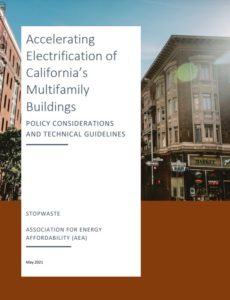Accelerating Electrification of California’s Multi-Family Buildings
“Accelerating Electrification of California’s Multi-Family Buildings,” produced by StopWaste and the Association for Energy Affordability (AEA)and funded by a Local Government Challenge grant from the California Energy Commission (CEC), offers policy considerations and technical guidelines for cities and building professionals to assess and develop solutions that make electrification of existing multi-family buildings possible regionally as well as at the state and national level.
California aims to reduce its greenhouse gas emissions by 40% before 2030. While zero-carbon construction for new buildings could significantly cut the overall emissions of California’s building stock, the majority of California’s multifamily buildings are existing properties with natural gas–powered space heating and water heating. As explained in Part 1, The Value Proposition of Electrification in Multifamily Housing, electrifying these buildings so that they are compatible with zero-carbon infrastructure will be a necessary step in achieving California’s goals.
While all-electric technologies and the solutions that make electrification of existing buildings possible have become increasingly prevalent, there is a lack of general knowledge about building electrification considerations and methods. A significant gap exists between the deep understanding held by many electricians and contractors and the knowledge required for decision making by building owners. As a result, going all-electric can be daunting to building owners who cannot easily gauge the cost and extent of the upgrades required. This lack of information stands as a barrier to achieving decarbonization in California’s existing building stock and may undermine the success of programs designed to encourage electrification unless it is quickly and widely addressed.
Part 2, Technical Considerations for the Electrification of Multifamily Buildings, provides an overview of electrical code, infrastructure, and technologies. A solid grasp of this information can enable building professionals to suggest and explain decarbonization methods appropriate to each building’s situation. Such a preliminary assessment by a building professional can elucidate the options available to a building owner, bringing the concept of electrification to a tangible level.
Regardless of the specific programs adopted by California to reach its decarbonization goals, whole building electrification assessments by building professionals and other program implementers will play a vital role in the ability of those programs to impact a wide sampling of buildings throughout the state.
Through this report and a separate white paper focusing on electrification of single-family residential buildings, government staff and implementers can gain deep insight into policy considerations and functional technical guidelines around electrifying existing residential buildings.
Written by Ben Cooper and Alma Freeman, from StopWaste
Local Government Commission Newsletters
Livable Places Update
CURRENTS Newsletter
CivicSpark™ Newsletter
LGC Newsletters
Keep up to date with LGC’s newsletters!
Livable Places Update – April
April’s article: Microtransit: Right-Sizing Transportation to Improve Community Mobility
Currents: Spring 2019
Currents provides readers with current information on energy issues affecting local governments in California.
CivicSpark Newsletter – March
This monthly CivicSpark newsletter features updates on CivicSpark projects and highlights.




